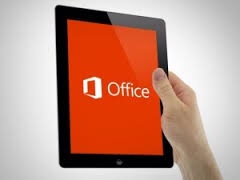During presentations to teachers and administrators about the 1:1 classroom for iPads or other devices, I introduce three “givens” for every program. These three are not only necessary for real student use in the the classroom, they also justify the cost of the program in substitution value alone. The first of these is obviously textbooks which can be of greater quality and lower cost when delivered digitally. The second is a levelled adaptive learning system that can provide individualized instruction and remediation. The third is a group of productivity apps allowing students to produce documents, spreadsheets, and presentations. Before any other apps, these create a framework for learning.
When talking about the productivity suite, there is always an unspoken context. No matter how I describe it, I am always really saying, “You know, the things we always did with Microsoft Office.” Office has been the gold standard for over ten years, and though competitors have arisen (and some have disappeared), there is a cultural understanding that all documents will be in this format. One of the fears I have heard from parents and teachers in iPad programs is that their students won't learn how to use Office and will be less qualified for the work force.
Other options are available, and until this weekend I have suggested three. As of September 2013, Apple made their productivity suite free with the activation of an iPad. This makes it difficult to recommend against Pages, Keynote, and Numbers, though I personally don't like using them and they don't blend well with MS Office documents. A number of schools have used the Google Drive tools, which are free, easy to use, and travel well across platforms. However, the iPad app is primitive (particularly the presentation tool), and the documents often lose all formatting when brought into other formats. I have always liked Office2HD (which has just changed name this weekend to Citrix QuickEdit). When the Apple suite were all pay apps, it was significantly cheaper, and the tools and controls were better than Pages (though again the presentation app was primitive). It also integrated seamlessly with Dropbox, and did the best job importing from and to Office formatted documents. This WAS the landscape…until this past week.
With remarkably little splash, Microsoft released their office suite for iPad. The appearance of Word, PowerPoint, and Excel finally gave iPad users that ability to view, edit, and create MS documents. I used each program briefly both to edit an existing document and create a new one. As with all other iPad word processors, it doesn't have all the functionality of the desktop product, but it was easy to use, with more tools than I expected. Best of all the apps were free…or so it seemed
However, this was far from a clean solution. First, most of the capability of these apps is dependent on having an Office 365 account. This is Microsoft's latest strategy to market their productivity giant. Rather than sell Office as a one-time purchase of roughly $300, Office 365 offers all of the Office Suite through a yearly subscription of $99. All in all this seems a fairly sensible approach. Most users don't use a single version for more than three years, and most attractively, one account allows the user to download the program on five desktop/laptop devices and five mobile devices.
The challenge is going to find a way to integrate this cost challenge into a school situation. If Microsoft were smart, they would make a single iPad account available for $10 per year/per student. No school is going to tack an extra $100 a year to the already slightly high cost of the iPad, but I could see them gratefully adding $10 to stay in the known universe.
If Microsoft continues to add functionality and solves the student price challenge, they will develop the same dominance in the tablet world that they experienced in desktops. Let's hope!
As always, I welcome your comments.

Would the schools be eligable for this?: http://www.techsoup.org/products/office-for-mac-2011-standard-edition-(includes-software-assurance)–LS-3013–
I liked Office2Hd as well-my colleagues did not. They preferred Pages and Keynote. Personally I can adapt to anything. Since I do have Office 365 (I cheated and bought the student version through my daughter), I may download it on my iPad and compare. Since I am given a limited app budget it’s hard to justify when iLife will come for free. Many of my teachers claim they function quite well with Notability and Haiku Deck.